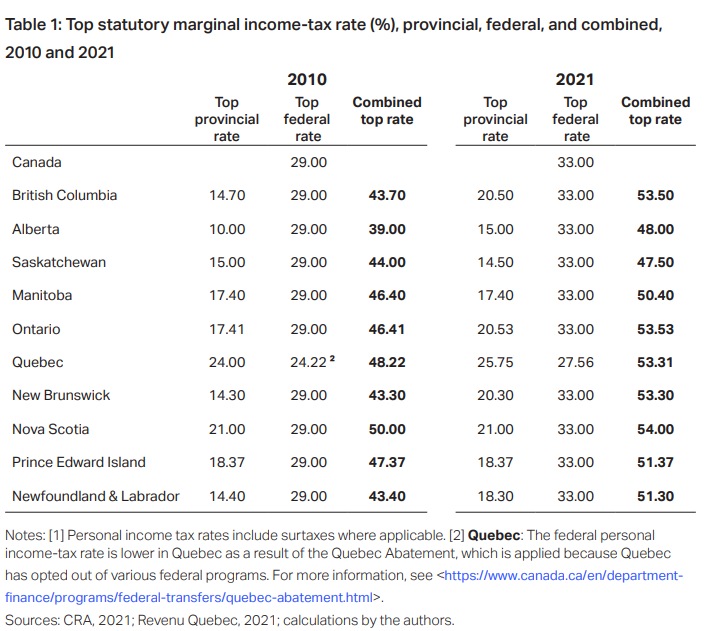Bigger government in Canada—there’s no free lunch

In recent years, governments across Canada have sought to raise additional revenue by increasing their top marginal income tax rate on high earners. In 2016, Prime Minister Justin Trudeau’s new government created a new top tax bracket, increasing the top federal marginal income tax rate from 29 per cent to 33 per cent. Meanwhile, six provinces have also increased the top marginal provincial tax rate.
The result has been a large cumulative increase to the top personal income tax rate across most of the country. Ontario’s top rate, for instance, has increased by approximately 7 percentage points. In Alberta, the increase has been 9 points. In British Columbia, just under 10 percentage points.
The table below shows how top marginal income tax rates across Canada have evolved since 2010.

Given the frequency with which this policy option has been employed, it’s important to assess the extent it has succeeded in achieving its goal of generating additional revenue from high-income earners. The evidence suggests that the answer is that these tax increases have generally not achieved their desired end.
When tax rates increase, people often change their economic behaviour in ways that shrink the tax base upon which that rate is applied. These behavioural changes include actual reductions in economic activity and various forms of tax avoidance. If the tax base shrinks enough, it can largely—or even entirely—offset the revenue gains that would otherwise result from a higher tax rate.
Studies suggest this is exactly what’s happened in Canada; that due to various behavioural changes, top rate increases (particularly the 2016 increase to the top federal rate) has produced disappointing revenue returns. Analyses by Smart and Uguccioni, Laurin, and Ferede all show significant base-shrinking behavioural changes that reduced federal revenue gains from the rate hike.
Further, once losses to provincial tax revenue are included (since the federal and provincial governments share the same tax base), the federal tax increases may have produced no additional aggregate tax revenues for governments across Canada. Quotations summarizing key findings from key studies are shown below.

Simply put, raising income tax rates on high earners will not necessarily generate more income tax revenue. A recent Fraser Institute study showed that efforts to generate enough tax revenue entirely from “the rich” to fund major expansions of government may be politically popular but they’re not, to say the least, easy to implement.
Instead, if governments wish to substantially increase government spending, they will likely have to increase taxes on individuals across a much broader share of the income spectrum. This means that a large group of taxpayers, not just a small group of “the rich,” will have to pay more. As attractive as it may be to promise taxpayers that additional programs can be funded by taxing only high earners, especially the top “one per cent,” in reality there’s “no free lunch for the 99 per cent” when it comes to a bigger government in Canada.

